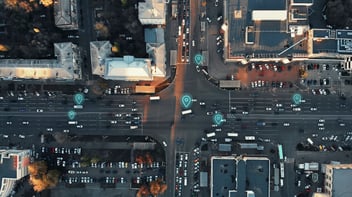

What Are The Differences Between LoRaWAN And NB-IoT?
When deploying and maintaining an IoT fleet, one of the most important decisions you'll make is your choice in connectivity. It impacts the battery life, roaming location, and overall reliability of your devices.
In this post, we will compare two of the most popular IoT connectivity options, LoRaWAN and NB-IoT. By the end of this post, you should have a solid idea of which is right for your fleet.
What is LoRaWAN and what is NB-IoT
First, let's start with a breakdown of these LPWAN technologies. LPWAN, short for Low-Power Wide Area Network, describes low-data, low-power networking technologies that have primarily been designed to suit the needs of IoT.
LoRaWAN
Short for Long Range Wide Area Network, LoRaWAN is an IoT connectivity solution built to keep battery-powered devices connected to the internet. Rather than concentrating high-bandwidth connectivity in a smaller range, it covers a larger range at the cost of smaller data packets.
Since IoT devices generally only need to send small packets of data periodically, it is well suited to this purpose.
One drawback of LoRaWAN, though, is that it's proprietary. Users will need to pay a small fee to access LoRaWAN connectivity, which can limit its availability in certain situations.
NB-IoT
Short for Narrow-Band IoT, NB-IoT is another connectivity solution specifically designed for the IoT sector. It helps keep small, low-power, short-range, low-data devices connected to the internet. And unlike LoRaWAN, NB-IoT is more specialised for stationary devices.
One of the key differences between LoRaWAN and NB-IoT is that NB-IoT is built on existing LTE infrastructure. This makes it easier to deploy, usually more affordable, and more available.
NB-IoT is also a proprietary technology, so again, users will need to pay an additional fee to access NB-IoT solutions.
What are the technical differences between LoRaWAN and NB-IoT?
As you may have realised by now, LoRaWAN and NB-IoT are very similar technologies. The differences between them are largely technical. To help you better distinguish between the two, here are the key technical differences between them.
LoRaWAN consumes less energy overall
LoRaWAN is better in terms of power consumption. Users can get up to 15+ years of battery life from devices connected to a LoRaWAN network. NB-IoT, on the other hand, only offers 10+.
This reduced power consumption also makes LoRaWAN ideal for devices that require higher refresh rates, as it will minimise the impact these higher refresh rates have on your battery usage.
Beyond that, LoRaWAN has few advantages over NB-IoT. The two connectivity options are largely the same regarding geolocation and peak data throughput.
NB-IoT provides better coverage and lower latency
While NB-IoT doesn't fare as well with battery life, it does provide better coverage and latency overall. You'll be able to deploy in more areas with less effort.
And thanks to NB-IoT's low latency, you can send larger packets of data faster. So for devices that need to transmit a larger or more consistent data stream, NB-IoT is the way to go.
Additionally, NB-IoT is more secure than LoRaWAN. It uses 256-bit 3GPP encryption versus LoRaWAN's AES 128-bit encryption. So if the data you're transmitting is sensitive, then NB-IoT is a more reliable option.
When should you use which technology?
To a certain extent, LoRaWAN and NB-IoT are relatively interchangeable. However, there are a few use cases where one outperforms the other. Here's a quick list of those use cases to help your decision-making.
LoRaWAN
LoRaWAN is particularly good at supporting static outdoor devices. This includes IoT fleets used for:
- Smart agriculture
- Smart home and building automation
- Warehouse monitoring
Users can take advantage of LoRaWAN's long-lasting battery life to set-and-forget outdoor IoT devices, as it will help reduce the maintenance involved. And while it can work in some indoor settings, it's best not to use LoRaWAN in dense environments.
NB-IoT
Conversely, NB-IoT works exceptionally well in dense settings. It can penetrate walls, buildings, and more without little impact on service quality. For that reason, it's the better option in these situations:
- Smart street lights
- Water and electric systems
- Smart parking
As you can see, each use case is set in an urban landscape, with walls, concrete, and other wireless users to contend with. Even still, NB-IoT remains a reliable and successful solution in these instances.
Sometimes, either will get the job done
There are some situations where one is just as good as the other. This includes:
- Utilities and smart metering
- Logistics and asset tracking
- Industrial manufacturing
- Wearables & pet tracking
Make the right networking choice, and opt for Velos IoT
Choosing the right LPWAN connectivity for your IoT fleet doesn't have to be a headache. We offer Connect LPWA solution with both CAT-M and NB-IoT coverages. Reach out to the Velos IoT team today by filling in the form below and get expert insights into which technology will best suit your own business needs.
Speak to a Velos IoT expert
Related articles


Different LPWAN Technologies Explained
It's important to note that LPWAN is not a single network technology but a group of low-power wide...

LTE-M vs NB-IoT: What are the differences?
When it comes to LPWAN options for IoT businesses, two LPWAN technologies stand out: LTE-Mand...
